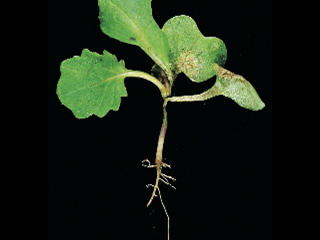Blackleg and the risk of sowing canola on canola
- South Stirling
- Gibson
- Howick
Plant pathologist Kithsiri Jayasena (DPIRD) has recently reported about blackleg spores being detected in spore traps around South Stirling.
Blackleg stem canker has also been reported by Agworld users on canola near Esperance and Gibson.
Technical officer Joel Kidd (DPIRD) has reported finding blackleg infection on lower leaves on canola seedlings near Howick.
Many WA growers have taken advantage of subsoil moisture reserves, widespread early rainfall and high canola prices to a sow a record area of canola in 2022. The early start to the season also means that some low rainfall areas in the eastern grainbelt that do not regularly sow canola have used this opportunity to sow more canola than normal. For more crop area and production estimates refer to the Grain Industry Association of WA’s 2022 Crop Reports page.
Canola being sown on previous canola paddocks poses a risk of increased blackleg infection due to exposure of emerging canola plants to blackleg inoculum on the previous season’s canola stubble.
What is blackleg?
Blackleg, caused by the fungus Leptosphaeria maculans, is one of the most serious diseases of canola in Western Australia. Blackleg can cause significant damage by infecting the cotyledons, or first leaves, early in the season, leading ultimately to crown lesions or cankers later in the season. The spores can also infect the crop in the late vegetative and flowering stage resulting in upper canopy infection (UCI).
Blackleg is spread primarily by wind, with the heaviest spore fall out occurring within 500 metres of any canola residue. Each year, canola residue continues to produce blackleg spores at a diminishing rate until the stubble has completely broken down.
The overall risk of blackleg infection on a property will be determined by factors such as choice of variety resistance group (and frequency of variety use), paddock rotation, time of sowing, fungicide usage, distance from previous year’s canola residues, and stubble reduction.
To minimise the risk of blackleg infection, growers should consider:
- Sowing into paddocks that are out of canola rotation for more than three years.
- Avoiding sowing within 500m of last year’s canola residues.
- Applying seed dressing and fertiliser applied fungicide. Reduced sensitivity to Jockey® and flutriafol has been reported in some WA blackleg populations. Please report any unexpected failures to your agronomist or DPIRD.
- Applying a foliar seedling fungicide in case of high disease pressure. You can assess your risk level by referring to GRDC’s Blackleg Management Guide 2022 Autumn Fact Sheet, and DPIRD’s BlacklegCM decision support tool.
For more information, refer to DPIRD’s Diagnosing blackleg in canola page.
Managing blackleg infection
For both blackleg stem canker and blackleg UCI, growers need to consider their varietal resistance levels before they spray as it may not be economical to spray varieties with high resistance level.
Fungicides applied during the bloom stage (before 50% bloom) may reduce UCI, and there are now some products, like AviatorXpro®, registered for use. These products should be applied at similar times to the fungicides used for Sclerotinia control. These fungicide applications for UCI are likely to be more economical in higher yielding crops.
For more information regarding canola variety resistance ratings and blackleg management, refer to GRDC’s Blackleg Management Guide 2022 Autumn Fact Sheet, and DPIRD’s Registered foliar fungicides for canola in WA page.
Deciding on your best course of action
DPIRD’s BlacklegCM is a useful decision support tool for assessing the value of spraying to manage blackleg stem canker during the 4-6 leaf stage. Growers can manually enter their crop specific details into the tool that relate to your sowing date and location and compare scenarios between different treatments or against leaving crops untreated. These risks can be found online at DPIRD’s blackleg spore maturity forecasts for Western Australia. BlacklegCM cannot be used to determine the value of flowering sprays for management of upper canopy infection.
For more information on this decision support tool, refer to DPIRD's BlacklegCM page. This tool is available for both Apple and Android tablet devices and can be downloaded for free from the respective app stores.
Canola blackleg risk forecasts
DPIRD's blackleg spore maturity forecasts for Western Australia for the 2022 growing season are available online. The latest forecast is current to 23 May 2022.
The forecasts show the expected risk during the 4-6 leaf stage, relative to the date of sowing. For crops sown in mid to late May, the risk of blackleg spore showers coinciding with the seedling susceptible stage is high at most locations within the state.
For more information, refer to DPIRD’s Canola blackleg spore maturity forecast for Western Australia page to check the blackleg model forecast for your district.
For more information about blackleg in canola contact Research scientist Andrea Hills, Esperance on +61 (0)8 9083 1144.
For more information about the blackleg risk forecast, or the BlacklegCM decision support tool, contact Senior research scientists Jean Galloway, Northam on +61 (0)8 9690 2172 or Adam Sparks, Perth on +61 (0)8 9368 3689.
Article authors: Jean Galloway (DPIRD Northam) and Cindy Webster (DPIRD Narrogin).
Article input: Andrea Hills (DPIRD Esperance), Adam Sparks (DPIRD Perth) and Amber Balfour-Cunningham (DPIRD Northam).


